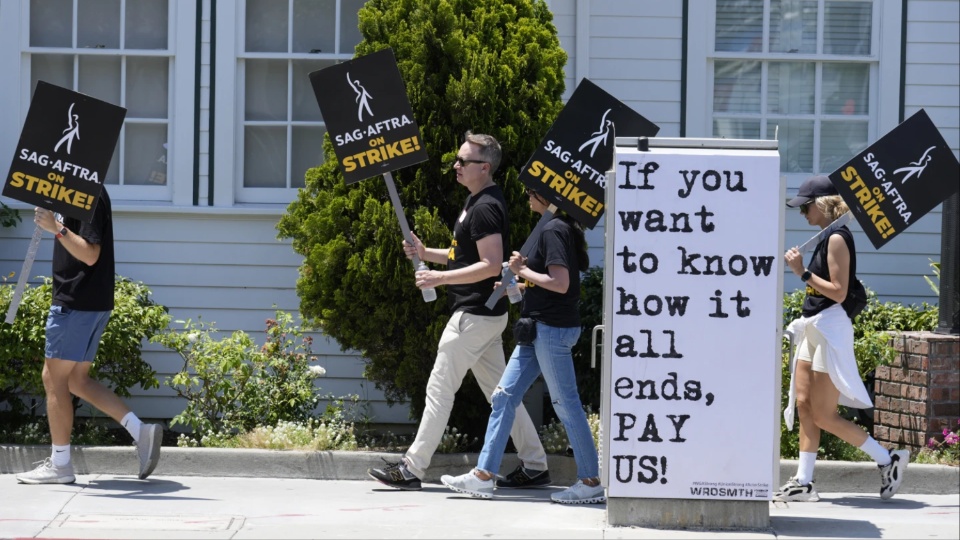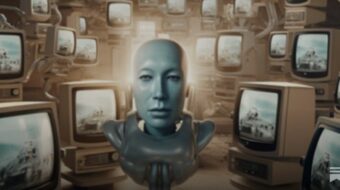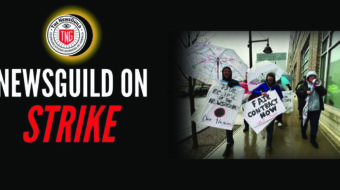
The Hollywood writers and actors strikes—the first time both unions have been on strike at the same time since 1960—have thrown the industry into an uproar as both groups together question and reverse some of the main rules of not only the Hollywood film and television industry but the way work as a whole is constructed and managed in the digital age.
The first precept being challenged is that unions and union solidarity are a dead letter in the era of Artificial Intelligence (AI) and ever-increasing corporate power and prestige as the twin answers to solving the world’s ills. The high profile of the two striking unions has drawn more attention and produced much more publicity for unions. The news stories in The New York Times, for example, have doubled since the actors joined the writers on strike, with most major publications feeling the need to generate stories from the picket lines where formerly the major news outlets concentrated mainly on the beginning and end of strikes.
This has produced a kind of reverse Blacklist effect. In 1947 the House Un-American Activities Committee(HUAC) decided that it would launch its campaign against radical elements in the labor force by first attacking Hollywood, and thus ensuring maximum publicity in its campaign of fear. Here the opposite is happening. In the wake of the Occupy Movement, and using some of that language, the coverage of the strikes of the two unions, largely favorable in the press since its readers are avid followers of films and television series, has prompted more favorable coverage of other strikes. Teamsters and nurses have shown up on the picket lines at the Hollywood studios, with the former helping to stop production in some cases, while the leaders of the Writers Guild joined hotel workers in a July 4th strike for higher wages.

On the actors’ picket line Fran Drescher, President of the Actors Guild, employed the Occupy language of the one percent to criticize executive salaries. She described one of the most powerful men in the industry, Disney’s President Michael Iger, who makes $27 million annually, as a dazzling example of the rampant inequality in pay structure. She claimed that she was on the line representing “the 99.9 percent of the membership who are working people who are just trying to make a living to put food on the table, pay rent and get their kids off to school” while labeling the Hollywood executives as “land barons of a medieval time.” This labeling not only echoes the language of the Occupy movement but is also drawn from a popular left characterization of a new Feudalism, with the majority of the population now in the position of serfs serving corporate lords.
One of the main claims of the writers is that they can no longer afford to live in a city they helped build as Los Angeles rents skyrocket. This claim is similar to the hotel workers who say they have to live outside the city and sometimes travel 90 to 100 miles to work. The writers’ claim was validated by a studio exec who, anonymously, told Deadline that the studio producers would “bleed out” writers and force them to “start losing their apartments.”
The second major tenet of Hollywood and the television industry which the strikes are challenging is the attempt to conceal profits and keep from paying residuals. For over 70 years the vast majority of television series operated on the principle of deficit financing. Producers and talent (writers, directors, and actors) understood that the vast majority of money being made on any television series would come after the series was sold into syndication. The “magic number” that would trigger these sales was 100 episodes. The show would then become profitable in perpetuity with its creators and financiers able to live off of these sales.
Part of the drive toward online subscription services, where the studio or streamer locks content behind a solid wall, is the elimination of these residuals, or the limiting of them, since the creators can no longer track how their work is being monetized. The streamers, on the other hand, have much more data and can track viewer habits minutely, down to the second when the viewer continues to watch or tunes out. The old system, with the Nielsen Ratings and with syndicated contracts, was much more transparent and allowed creators to track profits, though the studios often tried to conceal their gains.
A major demand of both strikes is finding a way to reclaim residuals in the age of streaming. The battle here goes beyond film and television writers and actors and encompasses the problems with monetizing digital work as a whole. Journalists, for example, often work for less or for nothing on internet publications while search engines such as Alphabet’s Google and Microsoft’s Bing accrue value by appropriating stories from news outlets and only reluctantly pay for this content.
The third major precept which the strikes are challenging is the parceling of work, a trend that is going on throughout the industry as a whole and which is being exacerbated by experiments with Artificial Intelligence and programs such as ChatGPT. The idea of breaking all kinds of work into tasks has of course been around since the Taylorist experiments with assembly lines in the 1920s. What is new, or as the owners say, “innovative,” is the potential ability, once the work is broken down into its component parts, to have laborers replaced with robotic replicators of their work or to reduce work to “smaller, more degraded, poorly paid jobs.”

One of the complaints of the actors, echoed even more strongly by the writers, is that “Our careers have been turned into gig work.” The meteoric rise in streaming has been fed by the work of writers creating television series of high quality and moving into all aspects of production, to make sure, like the Hollywood directors of old, that all aspects of the series (costuming, makeup, set construction) form a seamless whole. This expansion fueled the rise of more and better showrunners, responsible for the overall concept of the series.
The producers instead are attempting to limit the writers to just their time in the writing room, and then release them. Their preferred model is to pay a single creator an exorbitant salary (Shonda Rhimes—Bridgerton), Ryan Murphy—American Horror Story, Taylor Sheridan—Yellowstone) and dispense with the rest. The Writers Guild has been tracking this trend and says that writers’ time on a series has decreased because they are let go faster, and that in 2022 over half of the writers, stripped of their producing jobs, are being paid at the weekly minimum, as opposed to one-third eight years ago.

Contrary to the Tom Cruise version of AI in Mission Impossible: Dead Reckoning, where an all-powerful “Entity” threatens a machine takeover of the earth, the real challenge of AI, which this Hollywood fantasy version conceals, is that it will be used to un-employ workers in all kinds of industries as well as forcing them to work harder through its monitoring capacities. Thus, warehouse workers describe being tracked minutely, pressuring them to skip breaks, while setting them up for disciplinary actions if their goals are not met. The personal touch of service workers, whom one worker described as providing “a kind of therapy” to their clients, is discounted as their work is automated. A recent Biden administration summit to “regulate” AI rather than impose restrictions allowed the seven major makers of the service to voluntarily agree to guidelines. None of the restrictions even mentioned AI’s power to eliminate, tame and discipline the U.S. workforce.

A long-term goal for Hollywood’s use of AI is potentially to use the machine to grind out scripts that are then “created” not by the writer, but by the studio. The scenario for this goal involves the studio plugging in a basic concept with AI or ChatGPT which then churns out a (highly unworkable) script. A writer would then be hired to first turn the script into a workable scenario, but the credit, and the profits, would then go to the studio.
This is an attempt to turn television production back to the 1950s when, for example, Warners cheated the “showrunner” Roy Huggins out of the “Created By” credits for both Maverick and 77 Sunset Strip, two shows which kept the studio alive. For Maverick, the studio bought the rights to a book that a plot turn in the pilot employed and thus claimed it owned the property. With 77 Sunset Strip, Warners screened the pilot in a movie theater outside the U.S. and claimed the studio then owned the rights to “the film.” Huggins himself addressed this ignominy in his next contract with Universal which granted him the “Created By” credit and established it as a norm for the industry.
An actor on the picket line described AI as “a tool to generate wealth,” noting that the main task of the “Entity” was “cutting jobs for corporate profit.” Another Writers Guild member summoned up the end game as “creating material in the cheapest, most piecemeal, automated way possible” so that “one layer of high-level creatives take the cheaply generated material and turn it into something.” The actors and writers guilds’ demand to have control over how this process is used is a crucial attempt to counter this thrust.
We hope you appreciated this article. At People’s World, we believe news and information should be free and accessible to all, but we need your help. Our journalism is free of corporate influence and paywalls because we are totally reader-supported. Only you, our readers and supporters, make this possible. If you enjoy reading People’s World and the stories we bring you, please support our work by donating or becoming a monthly sustainer today. Thank you!












Comments